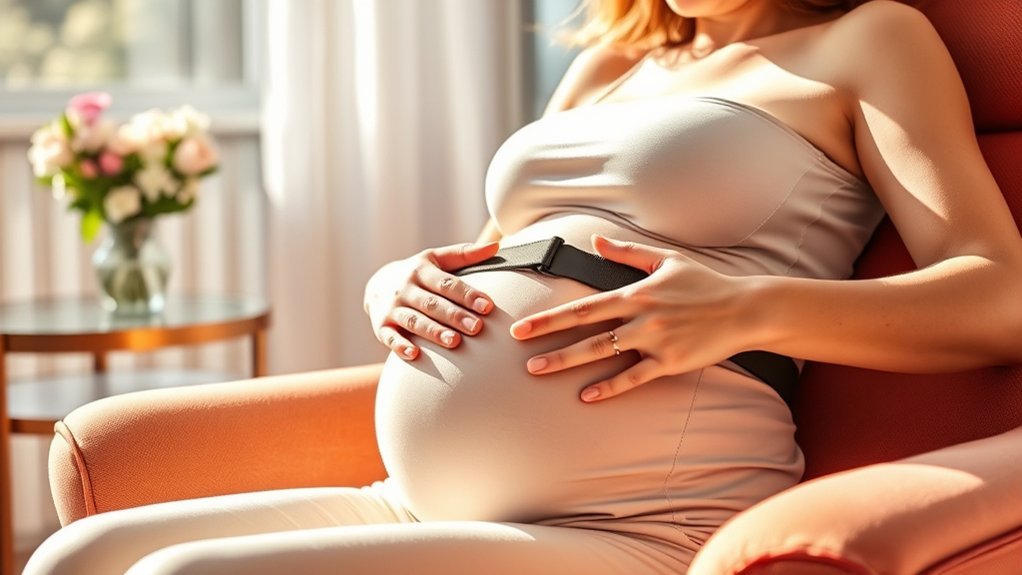Imagine guiding a winding road while carrying precious cargo; your choices about safety gear can make all the difference. During pregnancy, understanding how the LATCH system and seatbelts work together is essential for both your comfort and safety. Each option has its unique benefits and limitations, raising questions about which is best for you. Explore the nuances of these safety measures to guarantee a secure journey for you and your baby.
Understanding the Latch System: Benefits and Drawbacks
When considering safety during pregnancy, understanding the latch system can be crucial for expectant mothers. The latch system, designed to secure you in your vehicle, helps protect both you and your baby during travel. It attaches your baby seat directly to the car’s frame, reducing movement and providing stability. This system simplifies installation, ensuring your baby’s seat is correctly secured.
However, it has some drawbacks. If not used properly, it can lead to misalignment, compromising safety. Additionally, certain vehicles may have limited latch points, making it challenging to find an appropriate fit.
It’s important to familiarize yourself with your vehicle’s latch system to maximize safety. By doing so, you can make informed decisions that prioritize your wellbeing and your baby’s health.
The Role of Seatbelts During Pregnancy
While the latch system plays a notable role in securing infant car seats, seatbelts remain essential for the safety of pregnant individuals during travel.
Properly wearing a seatbelt can greatly reduce the risk of injury in the event of an accident. It’s important to position the lap belt under your belly, across your hips, and the shoulder belt between your breasts and to the side of your belly.
This placement minimizes pressure on your abdomen and protects both you and your unborn child. It’s also advisable to adjust your seat to guarantee comfort while maintaining an ideal distance from the airbag.
Comparing Safety Features: Latch vs. Seatbelt
Although both the LATCH system and seatbelts are designed to enhance safety during travel, they serve distinct purposes in protecting you and your unborn child. Understanding these differences can help you make informed decisions during your pregnancy.
Both LATCH and seatbelts play vital roles in protecting you and your unborn child during travel.
- LATCH (Lower Anchors and Tethers for Children): Specifically designed to secure car seats, minimizing movement during a crash.
- Seatbelts: Protect you by restraining your body, preventing injury in the event of sudden stops or collisions.
- Ease of Use: LATCH offers a simpler installation compared to seatbelts, reducing the risk of improper securing.
- Compatibility: Not all vehicles are equipped for LATCH; seatbelts are universally available.
Comfort Tips for Pregnant Women While Traveling
To guarantee a comfortable journey during pregnancy, consider implementing several strategies that address common discomforts.
First, wear loose-fitting clothing that allows for easy movement and circulation. Take frequent breaks to stretch your legs and relieve pressure on your back. If you’re traveling by car, adjust your seat to maintain proper posture; use a cushion for extra support if needed.
Stay hydrated by drinking water regularly, and keep healthy snacks on hand to maintain your energy levels. When possible, elevate your feet to reduce swelling.
Finally, consider using a pregnancy pillow for additional comfort during longer trips. By following these tips, you can help minimize discomfort and enjoy your travels more fully.
Making an Informed Choice: What Works Best for You
When considering the best safety option for you and your unborn child during travel, it’s crucial to weigh the benefits and drawbacks of both the latch system and traditional seatbelts.
Each option has unique qualities that may suit your needs better.
- Latch System: Often easier to install correctly, providing a secure fit.
- Traditional Seatbelt: More versatile for different vehicles, allowing for flexibility.
- Comfort: Consider how each option affects your comfort during long rides.
- Safety Ratings: Review crash test data to understand protection levels.
Ultimately, your choice should depend on your vehicle, personal comfort, and safety priorities.
Make informed decisions to guarantee both you and your baby remain safe and secure during your travels.
Frequently Asked Questions
Can I Use Both a Latch and Seatbelt Simultaneously?
You can’t use both a latch and seatbelt simultaneously. Doing so can compromise safety. It’s essential to choose one method that provides the best support and comfort for your situation during pregnancy.
Are There Specific Brands Recommended for Pregnant Women?
Like a well-tuned instrument, choosing the right brand is essential. Brands like Britax and Graco often receive recommendations for their safety and comfort features tailored for pregnant women. Always check for updated safety ratings before purchasing.
How Does Pregnancy Affect Car Insurance Policies?
Pregnancy can affect car insurance policies by prompting you to reassess coverage needs. You might consider additional protection for your growing family, which could lead to adjustments in premiums or policy options based on your circumstances.
What Should I Do if I Experience Discomfort While Using a Seatbelt?
If you’re feeling discomfort with your seatbelt, adjust its position or use a cushion for support. Always make certain it fits snugly across your lap, as safety’s essential for you and your baby during travel.
Are There Legal Requirements for Pregnant Women Regarding Car Safety?
Yes, legal requirements for pregnant women regarding car safety typically mandate using seatbelts. You should wear it properly, positioning the lap belt under your belly and across your hips, ensuring both your safety and your baby’s.
Conclusion
In traversing the delicate journey of pregnancy, choosing between the LATCH system and seatbelts is crucial for your safety and comfort. While both options offer distinct advantages, it’s essential to weigh their merits thoughtfully. Prioritizing your well-being through proper positioning, regular breaks, and hydration can enhance your travel experience. Ultimately, embracing a choice that aligns with your unique needs guarantees not just safety, but also peace of mind as you commence this significant chapter of your life.
